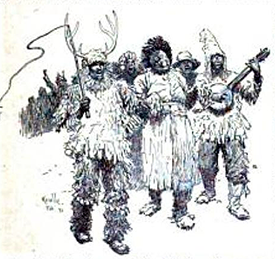
James Norcom described an "exhibition of John Cannu" in 1824 at a plantation near Edenton. Other celebrations were reported at Somerset Place Plantation (1829), in Bertie County (1849), and at various times in Southport, New Bern, Hillsborough, Martin County, and as far west as Iredell County.
In Wilmington, where newspapers regularly reported the practice through the 1850s, as many as eight to ten groups of Kuners, some with 20 members each, went from house to house, singing and beating rhythms with rib bones, cow's horns, triangles, and mouth harps. Kuners, who kept their identities secret, wore "tatters," or brightly colored rags sewn to their clothes, and masks, often made of buckram. All Kuners were men, although many dancers wore women's clothing. At each house, Kuners stopped to collect pennies. On plantations, they received small treats, rum, or desserts.
Historian Elizabeth A. Fenn has interpreted the custom as a "safety valve" for slave resentments and "a medium for social change and commentary." Some of the costumes and improvised verses seem to have poked fun at white hypocrisy and pretensions.
Kunering survived the Civil War and Emancipation but seems to have died out in Wilmington by the 1880s. Scholars have attributed its decline to black clergymen who denounced the practice as demeaning. Strict enforcement by white officials of laws relating to the wearing of masks may also have played a role. However, white youths in Wilmington, Fayetteville, Kinston, and other places continued to copy the custom into the early 1900s, dressing up and parading in blackface at Christmastime.